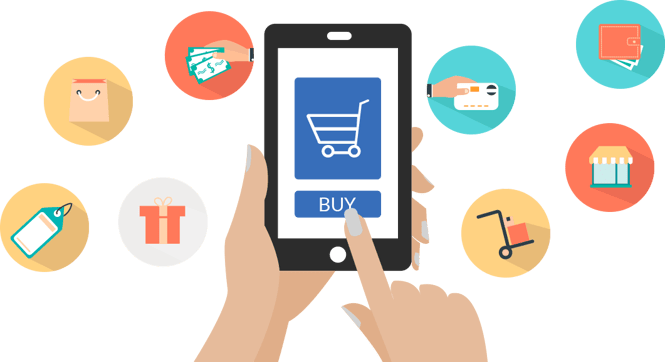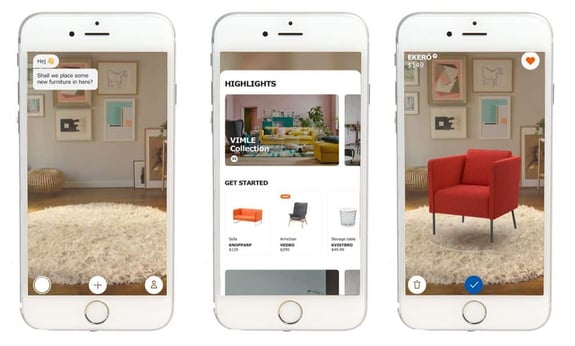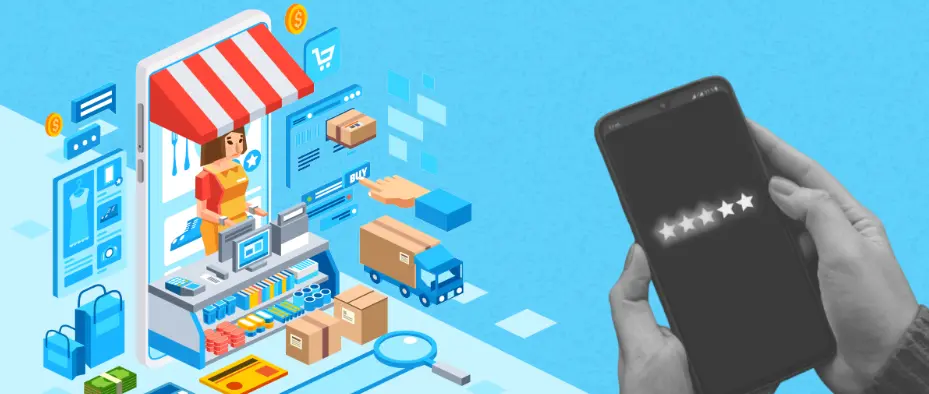Top 11 Mobile Commerce Trends You Should Follow To Drive More Sales
It is evident that the number of mobile users worldwide is massively increasing. It is expected that by 2025 the number of mobile users will reach 7.49 billion users ( Statista,2023).
Accordingly, as an e-commerce business, mobile devices are the gateway to your online business success. Hence, you have to keep up with the continuous emerging mobile commerce trends to ensure the success of your business.
Mobile commerce, also known as m-commerce, is a subset of e-commerce that involves selling products through mobile devices. Thus, m-commerce is a game changer.
As we realize the massive importance of m-commerce, in this article, we will show you 11 mobile e-commerce trends that will boost your e-commerce performance upon usage.
So, buckle up!
Top 11 Mobile Commerce Trends:
- Responsive Mobile Websites
- Mobile Apps
- Social Media Shoppable posts
- Mobile Payments
- OmniChannel Integration
- One Click Purchasing
- Chatbots On Mobile Apps
- Augmented Reality (AR)
- Leverage Personalization
- Optimize Voice Shopping
- Crypto Payments
Top Mobile Commerce Trends
As an e-commerce store, keeping up with emerging trends is the key to success. Accordingly, we will take you through 11 m-Commerce trends to watch out for in 2023.
1- Responsive Mobile Websites
 Image source: nicepage.com
Image source: nicepage.com
A responsive website is one whose page content fits a desktop, tablet, or mobile screen size.
Most websites are made to fit the screen size of a desktop and tablet. However, with the increasing mobile usage of customers, your e-commerce website must be mobile responsive. This means that the components of your website can be readily displayed when users open it from their mobile devices.
Customers use their mobile devices to learn more about your products, the available options and make a purchase. Accordingly, if your customers encounter a negative experience when visiting your website from their mobile, they will abandon your website out of frustration.
A study by Google showed that customers encountering an unpleasant experience on a website through their mobiles are 62% less likely to purchase from your brand in the future.
It is worth mentioning that the more your website is mobile responsive and faster in page loading, the higher it will be ranked on the Google result page. This is part of Google’s mobile indexing, which considers the page loading time to determine page ranking.
How to implement:
Plenty of procedures should be taken to benefit from such a mobile e-commerce trend.
- First, you must ensure your website is mobile-friendly by making your page elements clear and accessible for your mobile users. For example, you add full-screen images for your product, large and visible icons to suit the small size screen and menu navigation.
When combined, all of these elements will make your website responsive and easy to deal with for all your customers.
- Second, you must measure your website's page load speed. This can be done by visiting Google Page Speed insights. It gives you a score from 0 to 100; the higher the score, the better your website performs.
2- Mobile Apps
 Image source: mobibiz
Image source: mobibiz
Even though having a mobile responsive website is necessary, you have to go the extra mile and have a mobile app.
Studies showed that 57% of buyers prefer shopping through mobile apps over other channels (Heady,2021). Also, mobile apps have witnessed a 157% increase in conversion rate compared to websites (BuildFire,2023)
In addition, the usage of e-commerce apps has increased by 92% (Shopify,2022).
Therefore, all the numbers encourage you to start creating your mobile e-commerce app. Apparently, buyers enjoy their experiences on mobile apps more than on websites. Accordingly, they are more encouraged to purchase when using a mobile application.
This is likely linked to the fact that mobile apps are already created for being mobile optimized. Hence, they offer an enhanced seamless experience for customers.
How to implement:
Some aspects should be considered for creating a well-built mobile app for your e-commerce.
- Your app has to be minimalistic. Don’t clutter it with several designs, colors, and sizes.
- Create thumb-friendly screen zones.
- Make sure your app content is readable.
- Create simple registration and checkout process on your mobile app.
- Create clear menu navigation.
- Optimize your app for the app stores. This will make it more reachable and more subject to downloads.
3- Social Media Shoppable posts
It’s inevitable that by now, you have realized the vitality of social media in the growth and visibility of your e-commerce. However, social media is not only about sharing posts to raise awareness; it can also be used for shopping.
With 82% of social media users mentioning that they discovered a product and purchased it through social media and their mobile devices (Business of Apps,2022), it became apparent that social media is essential for shoppers.
Almost everyone uses social media at the time being. People keep scrolling until they find a product that catches their attention, and thus, they think of purchasing it.
We are pretty sure there is nothing new in this process. However, the new mobile e-commerce trend is the presence of social media shoppable posts. Just like you tag someone’s account on your Instagram picture, you can tag your products and create shoppable posts.
Accordingly, it becomes easier for your customers to complete a purchase without visiting your website or mobile app.
Simply, you benefit from the time your customers spend scrolling through social media from their mobile devices( which is a lot of time).
Discover Your Ultimate Guide To Social Commerce: Why and How To Use In 2022
How to implement:
The shoppable posts feature is available on Instagram, Facebook, and Pinterest. As for Facebook and Instagram, you can open the photo or video post, tag the product, add its name and you are done.
As for Pinterest, you must create a business account to enjoy the Pinterest buyable pins feature. After completing the business account, apply to Pinterest buyable pins. As soon as the platform confirms them, you can start adding products to your pins.
4- Mobile Payments
One of the popular mobile e-commerce trends is mobile payments. People used to pay for their purchases in cash, then things evolved, and credit cards became a thing. However, currently, mobile payments are accelerating as a payment method.
More than 2 billion people used mobile payments in 2021, which contributed to a 27% annual increase (Business of Apps, 2023).
Mobile wallets are an easier, quicker, and safer payment method utilized by customers to complete their online purchases.
Apple pay and Google pay allow such a feature by adding the customer’s credit card details to the wallet, thus, finalizing purchases efficiently.
Creating a convenient customer experience is necessary for every e-commerce and dominates the mobile e-commerce trends.
How to implement:
To keep up with such a trend, you must integrate mobile payments into your website and mobile app to complete transactions.
5- OmniChannel Integration

An omnichannel experience combines all your channels to create a single customer experience. Therefore, you sell your products through multiple channels like your website, mobile app, and physical store.
As an e-commerce store, you must remember that customers research through several channels before purchasing. Thus, you have to deliver a consistent customer experience, as this will affect their purchase decision.
So, you might think, how is this a mobile e-commerce trend?
Well, we have to tell you that incorporating mobile devices in all of your e-commerce tactics is essential.
To clarify, a study showed that 82% of customers consult their smartphones for the purchase decisions they are about to make in-store (Build Fire,2023). In addition, 27% of customers purchased a product through their mobile devices while visiting a physical store (Shopify,2022). Also, 59% of buyers order their products online and prefer to collect them from stores.
These statistics show that your e-commerce store will never know from which channel customers will make a purchase. Customers might be using a channel and end up purchasing from another one.
Accordingly, to deal with such a trend, you must deliver consistent messages by combining the online and offline customer experience. Such a combination will be successful through the integration of mobile devices.
How to implement:
There are plenty of tips that your e-commerce can use to benefit from the omnichannel mobile e-commerce trend:
- You can enable the location of your mobile app users and trigger push notifications with discounts as soon as they enter your physical store to encourage purchasing.
- Insert a QR code on your in-store products so customers can have the chance to scan the QR code and order them online. Such a tactic is beneficial when buyers need a specific size sold out in-store but available online.
- Enable the order online and collect in-store option.
6- One Click Purchasing
According to Shopify, 17% of customers will abandon their cart if the checkout process is long and complicated. This is consistent with a study showing that mobile website cart abandonment rates reach 97% (Build Fire,2023).
The high cart abandonment rate rises from the several steps required to complete a purchase from the mobile website. The small screen size and the unclear page elements make purchasing less convenient. Therefore, customers are more likely to fail to complete their purchases.
So, a mobile e-commerce trend started to emerge, which is one-click purchasing.
Initially used by Amazon, one-click purchasing is usually incorporated into mobile e-commerce apps. It allows the customers to enter their shipping and payment details only for the first time, and they will be saved on the application for future purchases.
As a result, in upcoming purchases, customers won’t have to re-enter their payment and shipping information again, thus, offering customers seamless checkout experiences. In addition, one-click purchasing will increase your e-commerce conversion rate.
How to implement:
To validate the one-click purchasing, you have to create a mobile app for your e-commerce. Accordingly, you will incorporate such a feature in your app by saving the customers’ details for subsequent purchases.
In addition, you can offer your customers several payment options to facilitate the completion of the transactions.
7- Chatbots On Mobile Apps
 source: Hubspot
source: Hubspot
One of the drawbacks of online shopping is the lack of interaction between the seller and the buyer.
The customer might have an inquiry regarding a particular product, but their inability to find an answer to such an inquiry might lead to an increased cart abandonment rate.
Therefore, chatbots became necessary to target such issues. Chatbots are computer programs that stimulate human conversations.
Although you might think chatbots belong to the past, integrating chatbots into mobile apps is a widely known mobile e-commerce trend.
Chatbots are usually used on websites but are left behind in the mobile world. Therefore, integrating them into mobile apps will be more accessible to customers and enable your e-commerce to enjoy all the benefits of the regular website chatbot.
Generally, chatbots are more efficient and effective than human representatives as mobile chatbots can handle several inquiries simultaneously while being available all day.
How to implement:
Incorporate chatbots into your mobile application as it will provide 24/7 customer service, reply to customers' inquiries, and even place orders. In addition, you can include chatbots on your social media accounts to instantly respond to customers’ requests.
8- Augmented Reality (AR)
Mobile e-commerce trends aim to tackle the problems customers encounter during their online shopping journey.
One of these problems is the absence of a sensory product experience. Accordingly, customers cannot touch or try the products before buying. In addition, customers might receive a product that does not suit their style and preferences just because they thought otherwise before purchasing.
Accordingly, with the strict return and exchange policy for most e-commerce businesses, customers are forced to deal with this product regardless of its suitability.
Therefore, one of the booming mobile e-commerce trends is AR. AR enables customers to try their products and know how they fit online, even before they have the product.
If you are not impressed, we don’t know what else will impress you!
Just imagine that a woman can try on a blouse virtually to see what the product looks like before purchase.
In addition, customers can use AR as a preview placement to visualize how a certain product fits in their home or office before buying.
The evolution of AR is a transforming trend in m-commerce. It increases customer interaction and removes any uncertainties hindering buyers from completing purchases.
How to implement:
To start benefiting from AR as a mobile e-commerce trend, some steps need to be followed:
- Identify your goals: You have to identify the goals of including AR in your mobile e-commerce. In addition, you must single out how you will benefit your customers and contribute to their shopping experience by including AR.
- Identify the tools: For effective AR technology, you have to identify the tools to be used, the licensing, and accessibility. Incorporating AR features into your mobile app will be one of the factors behind its success.
- Market your new feature: At the end of the day, you want your customers to know about this new feature and its benefits. Therefore, you must market your AR to benefit from such a trend.
9- Leverage Personalization
60% of online shoppers claim that e-commerce brands that don’t deliver personalized experiences are more likely to lose their customers’ loyalty (Statista, 2023).
So, personalization is essential for all e-commerce businesses to increase conversion and drive sales. It is regarded as one of the top mobile e-commerce trends.
Generally, e-commerce brands can monitor customers’ browsing history and offer them personalized messages compatible with their preferences. In addition, you can provide customers with suitable product recommendations.
Another aspect that adds personalization as a mobile e-commerce trend is the emergence of zero-party data.
The zero-party data includes information given voluntarily by customers to your e-commerce store. Accordingly, you won’t have to monitor customers’ browsing history to know their preferences; you can simply ask them for it.
How to implement:
To gather zero-party data, you can encourage customers to participate in online quizzes to learn more about them, their demographics, needs, and preferences.
Also, you can enable email marketing to share product recommendations consistent with buyers’ purchasing history. Convertedin is one of the tools that can successfully assist you in automating your email marketing and reaching astonishing results.
Additionally, your e-commerce can send surveys to buyers to get feedback on their last purchase.
All of these steps can be done through mobile devices as it’s the most used device by online shoppers.
10- Optimize Voice Shopping

Voice shopping is a novel feature that uses artificial intelligence to assist customers in shopping through their voice and mobile or a smart device.
To avoid being left behind, your e-commerce website and mobile app must optimize voice shopping.
Voice shopping is growing as one of the mobile e-commerce trends. The development of Siri and Alexa made customers lean towards using voice assistance in shopping.
Let’s get back to some numbers and statistics to see the importance of voice shopping.
- According to Shopify (2022), 33.2% of American consumers use voice search features for shopping.
- Also, 51% of consumers use voice assistance to search for products (Shopify, 2022).
- Additionally, Google showed that 27% of online users utilize the voice search feature from their mobiles.
As a result, voice shopping is undoubtedly a growing e-commerce trend for the mobile world. It offers convenience, rapidness, and accessibility to customers as they can easily order a product through such voice commands.
Yes, online shopping has become that simple.
The significance of voice commerce lies in the fact that it does not need any skills or expertise to deal with the new feature. The customer’s voice will be more than enough.
How to implement:
To optimize your mobile website and app for voice shopping, you have to:
- Make sure that your product page has all the details for your product to be easily detected through voice search.
- Your product details should be in an informal conversational form which means avoiding lengthy sentences and complicated words. Put yourself in the customer’s shoes and think about how they will describe a product they want to order. Then, use this description on your product page.
- Voice searches are usually in the form of questions. Thus, formulate your website and mobile app to respond to these questions rather than using an exact keyword search.
11- Crypto Payments
Cryptocurrency is revolutionizing e-commerce. It is a virtual payment system that offers fast, hassle-free transactions and minimal fraud potential.
For e-commerce businesses not to be left behind, they started to include cryptocurrencies as a payment option. For example, Shopify, Woocommerce, and Big commerce have the crypto payment feature.
Also, the development of crypto payments continued beyond this point. QR codes are generated by cryptocurrency wallets to facilitate the sending and receiving of cryptocurrencies and to complete faster mobile transactions.
Cryptocurrencies are coming strongly. Therefore, e-commerce businesses must keep up with crypto payments as a mobile e-commerce trend.
How to implement:
To incorporate crypto payments into your mobile e-commerce experience, you must get a digital wallet to receive your cryptocurrencies. An example of a digital wallet is coinbase. You must also spread the word to inform your customers about your new payment option. Including crypto payments in your e-commerce will provide you with more exposure.
 By
By

